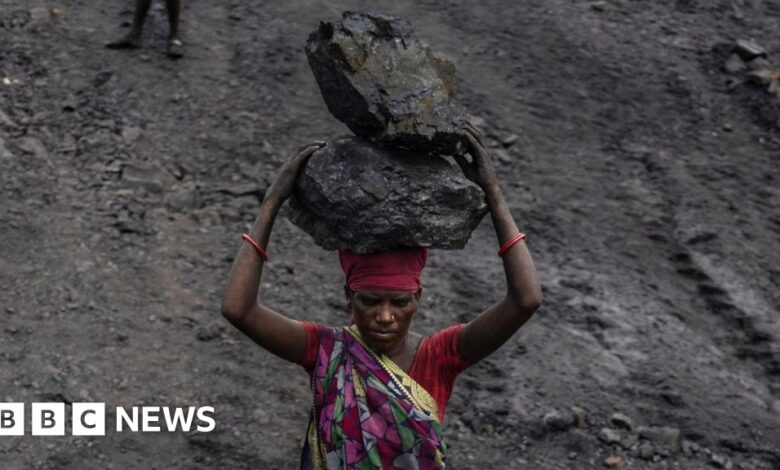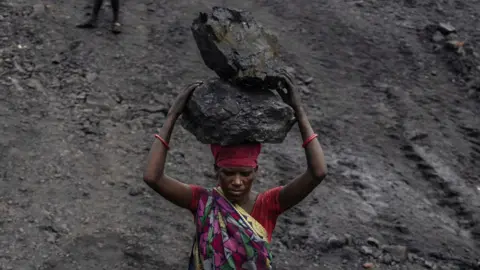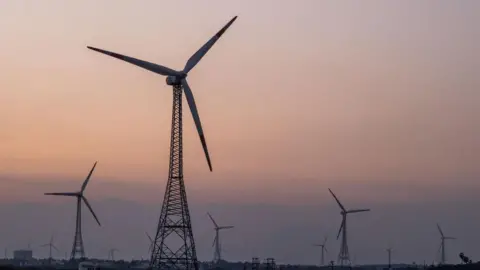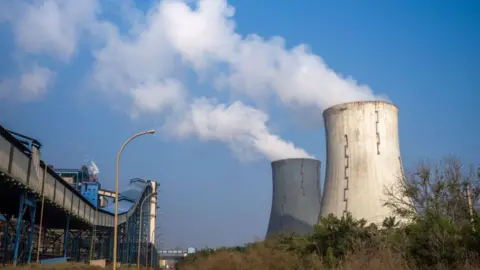Clean energy: India can’t wish away coal

Environment correspondent, BBC World Service
 Bloomberg via Getty Images
Bloomberg via Getty ImagesIndia has always taken a hard position on coal, arguing that it is crucial for its energy security and developmental needs.
But energy experts and environment campaigners are increasingly saying it should at least try to decarbonise or curtail emissions from coal-fired power plants, if it can’t be phased out altogether.
“You can’t wish away coal,” Ashok Lavasa, a former secretary of union ministries of finance, and environment, forest and climate change, said at an event on 1 July.
“The question is, if coal is king, then can it be a benevolent king?”
This signals to the fact that, realistically speaking, coal – albeit cleaner coal – may remain the primary power source of energy in India, despite years of international climate talks asking for the highly polluting fossil fuel to be phased out entirely.
But why has India – the world’s third largest carbon emitter – decided to stick to coal in the first place? After all, the country has international obligations to significantly cut its carbon emissions, along with its own target to bring down the levels to net zero by 2070.
A part of the answer lies in the rising power demands of the country.
India’s electricity demand has grown by more than 9% between 2021 and 2025, surpassing a previous prediction of 6.6% – and it is now forecasted to double by 2030.
Coal-fired power plants have generated more than 70% of the total electricity supply every year since the early 2000s – a figure that remains unchanged.
But the environmental cost of this reliance on coal is huge.
Estimates suggest that India’s electricity generation alone accounts for more than 40% of the annual carbon emissions – and nearly three-quarters of that electricity comes from coal-burning.
The country has made progress in meeting its renewable energy targets – it contributes 46% of India’s total installed capacity – but renewable sources have limitations. They generate electricity when the sun is up and the wind is blowing.
Even at daytime, experts say, supply from renewables can fluctuate, whereas thermal plants remain a constant source of electricity and are able to cater to peak demand in the evenings and at nighttime.
 Getty Images
Getty ImagesWhat’s more, India’s energy storage capacity – or the ability to store excess electricity from renewables at daytime – has not been able to keep pace with the expansion of resources.
“This means that there is no other option [other than thermal energy for constant supply] unless and until we have large-scale storage quantities in the system,” said Rajiv Porwal, director with Grid India, the grid controller of India under the ministry of power, speaking at the 1July event, organised by the Centre for Science and Environment (CSE).
Experts say constant supply from thermal plants is crucial for the stability of the grid, or the network of towers and transmission lines that carries electricity from power plants to consumers.
“Any large mismatch of demand and supply will destabilise the grid and that can mean power-cuts and blackouts, similar to what we recently saw in Spain,” says Anjan Kumar Sinha, an independent power sector expert.
With all these factors at play, India is looking to reduce emissions from coal-fired power plants, instead of phasing out coal completely.
A recent report by the CSE said that decarbonisation from coal-based thermal plants alone can cut down the country’s greenhouse gas emissions by 30%.
This is particularly significant given the country’s commitment to reduce emissions intensity (carbon emissions produced per unit of a country’s economic output) by 45% by 2030 under the United Nations Framework Convention on Climate Change.
 Bloomberg via Getty Images
Bloomberg via Getty ImagesBut there are challenges.
The common problem thermal plants face is that they must keep running at least at 55% capacity even at daytime, despite having alternate renewable sources like wind and solar power to rely on.
That’s because operators cannot ramp up capacity to the fullest at short notice, particularly during the peak hours of evening when supply from renewables is down.
Experts say there is an urgent need to make thermal plants more efficient so they can run at a lower capacity.
“How low can we go [to bring down the minimum running level threshold] is the question,” said Ramesh Veeravalli, a member with India’s Central Electricity Regulatory Commission, speaking at the event. “Technically it is possible.”
Another way to improve efficiency of plants is to adapt technologies that capture carbon dioxide emissions to keep them from escaping into the atmosphere
But some say this has produced limited results, with one estimate by the World Resources Institute saying the technology at present captures only about 0.1% of the global emissions.
A third suggestion is to burn agricultural residue in the place of coal in thermal plants.
“This idea has led to a substantial reduction in coal usage in thermal power plants in Delhi and surrounding cities,” said Parth Kumar, a programme manager with CSE that has suggested methods of reducing emissions in its recent report.
“But other parts of the country are yet to adopt this seriously, even though regulation requires them to,” he added.
Experts say that reducing emissions from coal-fired power plants would need larger systemic changes, involving huge costs.
But how much that cost would come down to – and who would bear it – are tough questions with no immediate answers.
Follow BBC News India on Instagram, YouTube, Twitter and Facebook
https://ichef.bbci.co.uk/news/1024/branded_news/455d/live/42877040-5e12-11f0-bcf2-4b73a304e829.jpg
2025-07-14 23:20:42






